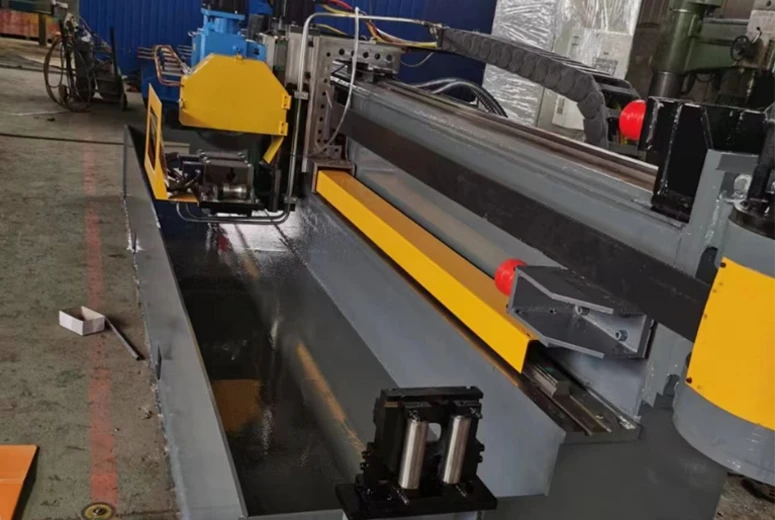Techniques and Innovations in Tube Forming and Machinery for Enhanced Manufacturing Efficiency
Tube Forming and Its Machine Technology
Tube forming is a pivotal process in various industries, including automotive, aerospace, construction, and manufacturing. It involves shaping and manipulating metal or plastic tubes into desired configurations for a wide range of applications. The technology of tube forming has evolved significantly over the years, driven by the need for precision, efficiency, and versatility in production. In this article, we will explore the techniques involved in tube forming and the machinery that facilitates these processes.
Understanding Tube Forming Techniques
Tube forming encompasses several methods, each of which is chosen based on the material properties of the tube, the desired geometric profile, and the production scale
. The most common techniques include bending, expanding, reducing, and stamping.1. Bending This is perhaps the most widely recognized technique in tube forming. The process can be done through various methods such as rotary bending, mandrel bending, and roll bending. Each of these methods allows for tight radius bends and is suitable for different tube sizes and types.
2. Expanding Tubes may need to expand at certain sections to fit into components or for aesthetic purposes. The expanding process can be achieved through hydraulic expansion or mechanical means, ensuring that the material maintains its integrity while increasing in diameter.
3. Reducing Similar to expanding, reducing involves decreasing the diameter of a tube at particular points. This technique is crucial in applications where a connection between different tube systems is necessary. It requires precise control to ensure that the dimensions remain within specified tolerances.
4. Stamping This technique involves creating specific shapes and designs on the surface of the tube. Die stamping is a common method whereby a die is used to imprint a design onto the tube surface. This is frequently used for branding or decorative purposes, as well as for enhancing functional features.
Machinery in Tube Forming
tube forming and machine

The machinery used in tube forming varies significantly based on the process and the material being worked with. Here are some key machines commonly employed in tube forming operations
1. Tube Benders These machines are designed specifically for bending tubes. They come in various configurations, including CNC (Computer Numerical Control) benders, which allow for intricate shapes and designs with high precision. The CNC technology enhances repeatability and allows operators to program multiple bending sequences for complex projects.
2. Hydraulic Expanders These machines facilitate the expansion of tubes through controlled hydraulic pressure. They can handle a variety of tube materials and shapes, making them versatile for different applications. Hydraulic expanders are important for achieving a smooth, uniform expansion without compromising the tube’s structural integrity.
3. Roll Forming Machines Roll forming is widely used for producing long lengths of tubes. This process involves passing a flat strip of metal through a series of rollers that progressively shape it into a tubular form. Roll forming machines can be adjusted to create various profiles and sizes, making them an essential tool in high-volume production environments.
4. Stamping Presses These powerful machines are used to create stamped designs on tubes. Stamping presses can handle multiple operations, including cutting, bending, and embossing, which can enhance the efficiency of the tube forming process.
5. End Forming Machines These specialized machines are employed for creating specific shapes at the ends of tubes, such as flaring or notching. They ensure that the tubes can seamlessly connect with other components, enhancing overall assembly processes.
Conclusion
The technology of tube forming plays an essential role in modern manufacturing, providing the means to shape and manipulate materials into functional components for various industries. With the ongoing advancements in machinery and techniques, tube forming is becoming increasingly efficient and capable of meeting the demands of modern production. As industries evolve, the importance of reliable tube forming processes and machinery will only continue to grow, solidifying their place as critical components in the manufacturing landscape. Ultimately, the fusion of innovative technology and traditional techniques will drive the future of tube forming, ensuring that it remains pivotal in creating products that fuel our world.
-
High Frequency Straight Seam Welded Pipe Production Line-BzZhou Xinghua Machinery Equipment Manufacturing Co., LTD.|line pipe steel&welded gas pipeNewsJul.30,2025
-
High Frequency Straight Seam Welded Pipe Production Line-BzZhou Xinghua Machinery Equipment Manufacturing Co., LTD.|High Precision&Automated SolutionsNewsJul.30,2025
-
High Frequency Straight Seam Welded Pipe Production Line - BzZhou Xinghua Machinery Equipment Manufacturing Co., Ltd.NewsJul.30,2025
-
High Frequency Straight Seam Welded Pipe Production Line-BzZhou Xinghua Machinery Equipment Manufacturing Co., LTD.|Precision Welding, High EfficiencyNewsJul.30,2025
-
High Frequency Straight Seam Welded Pipe Production Line|BzZhou Xinghua|Precision Welding&EfficiencyNewsJul.30,2025
-
High Frequency Straight Seam Welded Pipe Production Line - BzZhou Xinghua|Precision Engineering&EfficiencyNewsJul.30,2025


